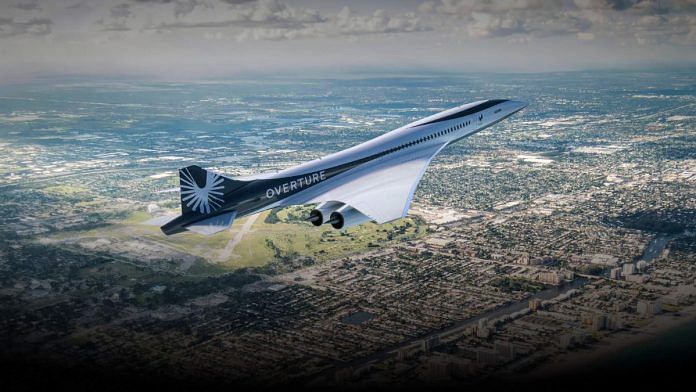New Delhi: “Boom! We cracked it! Today we are introducing Boomless Cruise,” exclaimed Blake Scholl, CEO of Boom Technology, a Colorado-based firm designing a supersonic airliner named Overture. Supersonic means having a speed greater than that of sound.
Boomless Cruise, a technology by Boom Technology, refers to supersonic flights that are up to 50 percent faster than conventional airliners. Boomless Cruise flights can reach speeds of up to Mach 1.3, or up to 1.3 times the speed of sound.
A unique aspect of these flights is that they do not produce any audible sonic boom. This technology was demonstrated on XB-1 or Baby Boom, a one-third-scale tri-jet supersonic demonstrator designed by Boom Technology.
On 28 January, Boom Supersonic conducted a supersonic flight with its demonstrator aircraft XB-1, which broke the sound barrier three times. In none of these three attempts did it cause an audible sonic boom.
A sonic boom is a loud, explosive sound heard when an object, such as an aircraft, travels faster than the speed of sound, creating shock waves that the human ear detects as a distinct boom-like noise.
“Because people will fly more when flights are faster, the market for supersonic jets will be much larger than the market for subsonic. So if we succeed, Boom will need to be much bigger than Boeing and Airbus,” Scholl posted on X, a day after the test demonstration.
The science & future of the technology
Boomless Cruise does not require extensive aircraft shaping; rather, it works on the principle of Mach cutoff physics, where the aircraft breaks the sound barrier at a sufficiently high altitude.
This concept is similar to the refraction of light, where light changes direction and speed based on variations in density and temperature of the medium in which it travels.
Similarly, the speed of sound varies with the temperature of the medium, which changes with altitude. Sonic booms refract in the colder atmosphere, making a U-turn instead of reaching the ground.
“These Boomless Cruise flights require engines powerful enough to break the sound barrier at an altitude high enough that the boom has sufficient altitude to U-turn,” Scholl wrote on X.
He further explained on X that the Symphony engines being developed for Overture have enhanced transonic (having speeds close to that of sound) performance, allowing the aircraft to break the sound barrier at an altitude high enough for Boomless Cruise.
These engines enable Overture to efficiently transition to supersonic speeds at altitudes above 30,000 feet.
Boomless Cruise is also enabled by advanced autopilot mechanisms, which use real-time weather data and algorithms to adjust the speed of the aircraft accordingly.
However, current regulations in the United States—including FAA regulation 14 CFR 91.817—prohibit supersonic flight over land, even if no audible sonic boom is produced.
Expressing his concerns about these restrictions, Scholl wrote on X, “We look forward to working with regulators to update these regulations to unlock business supersonic flight over land.”
These innovations have further strengthened American leadership in the aviation sector, which contributes more than 2.3 percent of the US gross domestic product (GDP). Moreover, they are expected to create a multiplier effect, generating more jobs and supporting ancillary industries in the country.
Another significant aspect is the strategic military potential of Boomless Cruise. If adopted for defence purposes, this technology could enhance the efficiency of military operations, improving national security while simultaneously increasing the security dilemma for other major global powers.
Sneha Yadav is an intern with ThePrint.
(Edited by Radifah Kabir)
Also Read: Search for an Indian Carl Sagan is on. Science influencers are being trained in labs and likes






